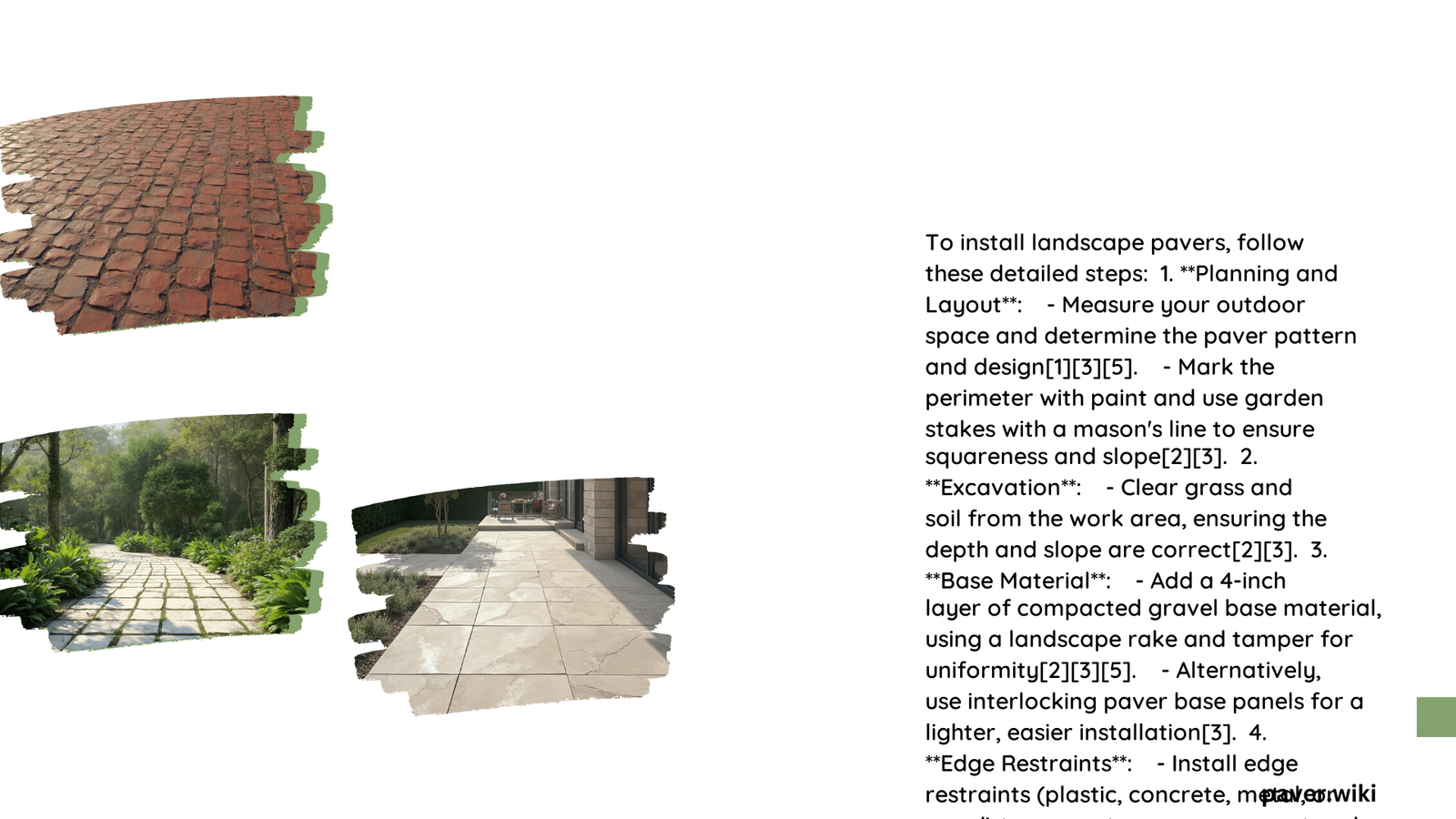Installing landscape pavers is a popular DIY project that can transform outdoor spaces. This process involves site preparation, excavation, base construction, and precise paver placement. Proper installation ensures durability, aesthetics, and functionality. This guide covers essential steps, tools, materials, and considerations for successful landscape paver installation.
What Are the Key Steps in Installing Landscape Pavers?
- Site Preparation
- Excavation
- Base Construction
- Sand Bed Creation
- Paver Laying
- Edge Restraint Installation
- Compaction
- Joint Filling
How Do You Prepare the Site for Landscape Pavers?
Site preparation is crucial for a successful paver installation:
- Measure the project area accurately using a tape measure
- Calculate square footage to determine material quantities
- Mark the perimeter with stakes and string
- Ensure proper slope for drainage (1 inch drop per 8 feet)
What’s Involved in Excavating for Landscape Pavers?
Proper excavation sets the foundation for your paver project:
- Dig to the required depth, considering:
- Paver thickness
- Gravel base layer
- Sand layer
- Example: For 2 ⅝ inch pavers, 6-inch gravel base, and 1-inch sand, excavate to 9 ⅝ inches
How Do You Construct a Solid Base for Landscape Pavers?
A solid base is essential for long-lasting paver installation:
- Add 4-6 inches of compacted gravel
- Spread evenly with landscape rakes
- Compact using a plate compactor or hand tamper
- Ensure a solid, level base
| Base Material | Recommended Depth |
|---|---|
| Clean Gravel | 4-8 inches |
| Crushed Stone | 4-8 inches |
What’s the Process for Creating a Sand Bed?
The sand bed provides a smooth surface for paver placement:
- Add a 1-inch layer of paver sand over the compacted gravel
- Use a level and 2×4 board to smooth and level the sand
- Ensure even distribution and a level surface
How Do You Properly Lay Landscape Pavers?
Proper paver laying ensures a professional finish:
- Start from a corner, working outward
- Place each paver straight down into the sand
- Fit pavers snugly together
- Avoid dragging or stomping pavers
What’s the Best Way to Cut Pavers When Necessary?
Sometimes, you’ll need to cut pavers to fit:
- Mark the cutting line with a straight edge and marker
- Use a masonry saw to cut the paver
- Wear safety gear (gloves, protective eyewear)
How Do You Install Edge Restraints for Landscape Pavers?
Edge restraints prevent shifting and maintain paver alignment:
- Use concrete molded edging or other suitable materials
- Install along the perimeter of the paved area
What’s Involved in Compacting and Finishing Landscape Pavers?
Final steps ensure a stable and polished paver installation:
- Use a plate compactor to tamp down pavers
- Fill gaps between pavers with polymeric sand
What Tools Are Required for Installing Landscape Pavers?

Essential tools for paver installation include:
- Tape measure
- Levels (including laser levels)
- Landscape rake
- Plate compactor or hand tamper
- Garden hose
- Shovels and digging tools
- Mallet and hammer
- Utility knife
- Mason’s line and stakes
- Saw with concrete blade
- Edging materials and spikes
What Are the Best Materials for Landscape Pavers?
Choose the right paver material for your project:
Concrete Pavers
- Durable and versatile
- Cost: $3 to $10 per square foot
- Ideal for driveways, patios, and walkways
Brick Pavers
- Aesthetic appeal and durability
- Cost: $5 to $15 per square foot
- Suitable for historic or traditional settings
Natural Stone Pavers
- High durability and unique appearance
- Cost: $10 to $30+ per square foot
- Perfect for high-end projects
What Are the Average Costs for Landscape Paver Installation?
Understanding costs helps in project planning:
- Total cost: $10 to $30+ per square foot
- Materials: $5 to $20 per square foot
- Labor: $5 to $10 per square foot
Additional expenses may include:
– Drainage solutions
– Edging ($1 to $3 per linear foot)
What Are Critical Factors Affecting Landscape Paver Base Preparation?
Several factors influence base preparation:
- Soil Type Analysis
- Sandy soils may need stabilization
-
Clay soils may require improved drainage
-
Compaction Techniques
- Use plate compactor or hand tamper
-
Ensure a solid, stable base
-
Moisture Content Requirements
- Base material should be slightly moist
-
Avoid over-saturation
-
Potential Challenges
- Drainage issues: Ensure proper slope
- Frost heave: Adequate base depth in freezing climates
By following these steps and considering these factors, you can successfully install landscape pavers and create a beautiful, durable outdoor space.
